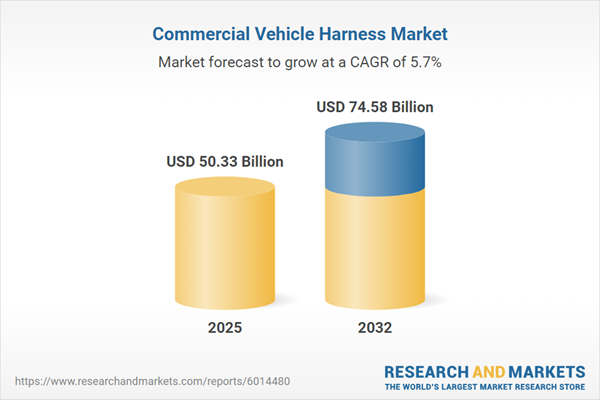Speak directly to the analyst to clarify any post sales queries you may have.
The commercial vehicle harness market is entering a phase of rapid transformation, driven by electrification, regulatory evolution, and increasingly sophisticated vehicle architectures. Senior leaders face unprecedented opportunities and challenges as harnesses become strategic program enablers rather than routine components.
Market Snapshot: Commercial Vehicle Harness Market Outlook
The Commercial Vehicle Harness Market grew from USD 47.72 billion in 2024 to USD 50.33 billion in 2025. It is expected to continue growing at a CAGR of 5.73%, reaching USD 74.58 billion by 2032. This robust growth reflects intensified global demand for harness systems supporting electrified and data-rich vehicle platforms. The market’s evolution is shaped by advancements in safety standards, propulsion technologies, and end-user expectations for durability and traceability. Commercial vehicle OEMs and suppliers are prioritizing solutions that can accommodate regulatory shifts and supply chain complexity.
Scope & Segmentation
- Component Type: Connectors, Relays, Terminals, Wires
- Material Type: Aluminum Wiring, Copper Wiring, Optical Fiber Wiring
- Propulsion Type: Electric Vehicles, Hybrid Vehicles, Internal Combustion Engine Vehicles
- Vehicle Type: Heavy Commercial Vehicles, Light Commercial Vehicles
- Sales Channel: Aftermarket, OEMs
- Application: Chassis (including Steering and Suspension Systems), Engine Systems, Infotainment Systems, Lighting Systems, Safety Systems (covering Advanced Driver Assistance Systems and Brake Systems)
- Regions: Americas (U.S., Canada, Mexico, Brazil, Argentina, Chile, Colombia, Peru), Europe, Middle East & Africa (UK, Germany, France, Russia, Italy, Spain, Netherlands, Sweden, Poland, Switzerland, UAE, Saudi Arabia, Qatar, Turkey, Israel, South Africa, Nigeria, Egypt, Kenya), Asia-Pacific (China, India, Japan, Australia, South Korea, Indonesia, Thailand, Malaysia, Singapore, Taiwan)
- Company Coverage: Key market participants include ACOME Company, Amphenol Corporation, Aptiv PLC, BizLink Group, Coroplast Fritz Müller GmbH & Co. KG, Cypress Holdings Ltd., Delphi Display Systems, Dräxlmaier Group, Emerson Electric Co., Flex Wires Inc., Fujikura Ltd., Furukawa Electric Co., Ltd., Genco Industries, Inc., Hirschmann Automotive GmbH, Kromberg & Schubert Automotive GmbH & Co. KG, Kyungshin Corporation, Lear Corporation, Leoni AG, Molex, LLC, Motherson Group, Nexans autoelectric GmbH, PKC Group Ltd., Renhotec Group Ltd, Robert Bosch GmbH, Sumitomo Electric Industries, Ltd., TE Connectivity Ltd., THB Group, Winsenda(HongKong)Co.,Limited, and Yazaki Corporation.
Key Takeaways for Senior Decision-Makers
- Electrification and regulatory safety standards are driving a shift from traditional wiring assemblies to advanced harness systems with integrated data and energy functionalities.
- OEMs and tier suppliers face new multidisciplinary engineering challenges, including the need for electromagnetic compatibility, thermal management, and robust manufacturing processes.
- Supplier selection now hinges on depth of engineering expertise, vertical integration, and capabilities in modular, high-voltage, and optical harness technologies.
- Regional regulatory priorities and supply chain clustering directly affect material sourcing, traceability, and speed to market across major global hubs.
- Strategic procurement increasingly incorporates scenario planning for tariff shifts, supply chain resilience, and supplier footprint adaptation to mitigate risk.
- Investment in automation, digital quality assurance, and advanced testing protocols is critical for maintaining consistency and meeting evolving compliance standards.
Tariff Impact on Sourcing and Procurement
Recent tariff changes in markets like the United States have significantly influenced sourcing decisions, procurement strategies, and overall supply chain design. As trade environments become more volatile, industry stakeholders are diversifying supplier bases and renegotiating long-term agreements to better absorb cost fluctuations. Proximity to assembly plants and investment in localized production serve as practical risk management measures, though sometimes at higher operational cost.
Methodology & Data Sources
This report leverages primary technical interviews with OEM and supplier experts, secondary reviews of industry standards, and direct supplier assessments. Comprehensive analysis ensures findings are grounded in real-world practices, technical literature, and current qualification protocols relevant to the commercial vehicle harness ecosystem.
Why This Report Matters
- Enables informed decisions by connecting harness design, procurement, and compliance practices with market and regulatory trends.
- Supports risk mitigation strategies related to tariff shifts, technology adoption, and supply chain resilience.
- Empowers leadership with actionable insights on supplier capabilities, regional dynamics, and future program scalability.
Conclusion
Harness solutions now stand at the core of successful commercial vehicle programs. Proactive alignment of design, sourcing, and compliance will be essential as vehicle platforms and regulatory landscapes continue to evolve.
Additional Product Information:
- Purchase of this report includes 1 year online access with quarterly updates.
- This report can be updated on request. Please contact our Customer Experience team using the Ask a Question widget on our website.
Table of Contents
3. Executive Summary
4. Market Overview
7. Cumulative Impact of Artificial Intelligence 2025
Companies Mentioned
The companies profiled in this Commercial Vehicle Harness market report include:- ACOME Company
- Amphenol Corporation
- Aptiv PLC
- BizLink Group
- Coroplast Fritz Müller GmbH & Co. KG
- Cypress Holdings Ltd.
- Delphi Display Systems
- Dräxlmaier Group
- Emerson Electric Co.
- Flex Wires Inc.
- Fujikura Ltd.
- Furukawa Electric Co., Ltd.
- Genco Industries, Inc.
- Hirschmann Automotive GmbH
- Kromberg & Schubert Automotive GmbH & Co. KG
- Kyungshin Corporation
- Lear Corporation
- Leoni AG
- Molex, LLC
- Motherson Group
- Nexans autoelectric GmbH
- PKC Group Ltd.
- Renhotec Group Ltd
- Robert Bosch GmbH
- Sumitomo Electric Industries, Ltd.
- TE Connectivity Ltd.
- THB Group
- Winsenda(HongKong)Co.,Limited
- Yazaki Corporation
Table Information
| Report Attribute | Details |
|---|---|
| No. of Pages | 199 |
| Published | November 2025 |
| Forecast Period | 2025 - 2032 |
| Estimated Market Value ( USD | $ 50.33 Billion |
| Forecasted Market Value ( USD | $ 74.58 Billion |
| Compound Annual Growth Rate | 5.7% |
| Regions Covered | Global |
| No. of Companies Mentioned | 30 |









